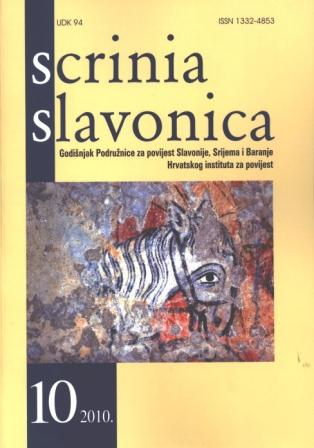Javni spomenici, radovi zagrebačkih arhitekata, u Kupinovu, Novom Slankamenu i Vezircu kod Petrovaradina
Public monuments built by architects from Zagreb in Kupinovo, Novi Slankamen and Vezirac near Petrovaradin
Author(s): Dragan DamjanovićSubject(s): History
Published by: Hrvatski institut za povijest
Keywords: Martin Pilar; Hektor von Eckhel; Hermann Bollé; historicism; monument
Summary/Abstract: A number of public monuments were put up all over Europe in the second half of the 19th century, since the need to honor important historical figures and events intensified as national ideologies were spreading. A similar process can be observed in Croatia. True, public monuments of large dimensions were relatively scarce in Croatian historicism, primarily because there was little money to finance such endeavors. A monument that would be bigger and more representative than Jelaèiæ’s monument in Zagreb, chronologically standing at the very beginning of historicist monument sculpting in our country (it was erected 1864-1865), is almost impossible to find in the period preceding World War I. Public monuments from historicism can be classified into three principal categories: monuments dominated by sculpture (usually a single sculpture, but sometimes also a group of sculptures); monuments combining elements of sculpture and architecture; and architectural monuments. We find purely architectural monuments the most interesting category in this context, since all three monuments designed and built by architects from Zagreb in the eastern regions of Srijem belong to it. The monuments in question are interesting products of late historicism. Two of the monuments have been preserved until this day (the one in Slankamen and the one in Petrovaradin) and are counted among rare public monuments from this period in both Croatian and Serbian architecture that have been preserved. Two of the monuments have been built by Croatian students of the Viennese architect Friedrich Schmidt: the monument in Kupinovo was built by Martin Pilar (1889) and the monument in Vezirac (1902) by Herman Bollé, one of the most important Croatian architects from the end of the 19th and the beginning of the 20th century. The third and the most representative monument, located in Novi Slankamen and overlooking the Danube (1892), was built by Hektor Eckhel, a professor at Zagreb’s School of Crafts and one of Bollé’s long-standing colleagues, which means it basically originated from the same context. The monument in Kupinovo, designed in Neo-Renaissance style, was erected to honor the late Prince Rudolf, heir to the throne, in the year of his suicide, commemorating his visit to Obedska bara, where he had come on a hunting trip in 1885. The monument in Novi Slankamen was erected to honor the great victory of the Austrian army over the Ottoman Turks in 1691. Duke Wilhelm of Baden-Baden, whose ancestor Ludwig had led the Austrian army in this battle, was the principal sponsor of this monument. The monument, designed in Neo-Renaissance style, was erected in 1892 and is shaped as an obelisk resting on four columns with a sarcophagus in between them, bearing inscriptions commemorating the events from 1691.
Journal: Scrinia Slavonica
- Issue Year: 2010
- Issue No: 10
- Page Range: 226-243
- Page Count: 18
- Language: Croatian

